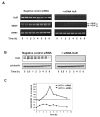Antagonistic functions of tetradecanoyl phorbol acetate-inducible-sequence 11b and HuR in the hormonal regulation of vascular endothelial growth factor messenger ribonucleic acid stability by adrenocorticotropin
- PMID: 16306087
- PMCID: PMC2214857
- DOI: 10.1210/me.2005-0121
Antagonistic functions of tetradecanoyl phorbol acetate-inducible-sequence 11b and HuR in the hormonal regulation of vascular endothelial growth factor messenger ribonucleic acid stability by adrenocorticotropin
Abstract
Expression of vascular endothelial growth factor (VEGF), an endothelial cell-specific mitogen and a potent angiogenic factor, is up-regulated by a variety of factors including hypoxia, growth factors, and hormones. In the adrenal cortex, regulation of VEGF expression by the pituitary hormone ACTH ensures the maintenance of the organ vasculature. We have previously shown that ACTH evokes a rapid and transient increase in VEGF mRNA levels in primary adrenocortical cells through transcription-independent mechanisms. We further demonstrated that the zinc finger RNA-binding protein Tis11b (tetradecanoyl phorbol acetate-inducible-sequence 11b) destabilizes VEGF mRNA through its 3'-untranslated region (3'-UTR) and that Tis11b is involved in the decay phase of ACTH-induced VEGF mRNA expression. In the present study, we attempted to determine the mechanisms underlying ACTH-elicited increase in VEGF mRNA levels in adrenocortical cells. We show that ACTH triggers an increase in the levels of the mRNA-stabilizing protein HuR in the cytoplasm and a concomitant decrease in the levels of HuR in the nucleus. This process is accompanied by an increased association of HuR with the nucleocytoplasmic shuttling protein pp32, indicating that ACTH induces HuR translocation from the nuclear to the cytoplasmic compartment. Leptomycin B, a specific inhibitor of CRM1-dependent nuclear export of pp32, significantly reduced ACTH-induced VEGF mRNA levels. Furthermore, RNA interference-mediated depletion of HuR in adrenocortical cells abrogated ACTH-induced VEGF mRNA expression. Finally, we show that Tis11b and HuR exert antagonistic effects on VEGF 3'-UTR in vitro. Although both proteins could bind simultaneously on VEGF 3'-UTR, Tis11b markedly decreases HuR-binding to this RNA sequence. Altogether, these results suggest that the RNA-stabilizing protein HuR is instrumental to ACTH-induced expression of VEGF mRNA and that the nuclear export of HuR is a rate-limiting step in this process. HuR appears to transiently stabilize VEGF transcripts after ACTH stimulation of adrenocortical cells, and Tis11b appears to subsequently trigger their degradation.
Figures







Similar articles
-
Identification of two novel ACTH-responsive genes encoding manganese-dependent superoxide dismutase (SOD2) and the zinc finger protein TIS11b [tetradecanoyl phorbol acetate (TPA)-inducible sequence 11b].Mol Endocrinol. 2002 Jun;16(6):1417-27. doi: 10.1210/mend.16.6.0844. Mol Endocrinol. 2002. PMID: 12040026
-
Destabilization of vascular endothelial growth factor mRNA by the zinc-finger protein TIS11b.Oncogene. 2004 Nov 11;23(53):8673-80. doi: 10.1038/sj.onc.1207939. Oncogene. 2004. PMID: 15467755
-
Expression of vascular endothelial growth factor-A and mRNA stability factor HuR in human astrocytic tumors.Neuropathology. 2008 Dec;28(6):604-11. doi: 10.1111/j.1440-1789.2008.00926.x. Epub 2008 May 21. Neuropathology. 2008. PMID: 18498284
-
HuR and mRNA stability.Cell Mol Life Sci. 2001 Feb;58(2):266-77. doi: 10.1007/PL00000854. Cell Mol Life Sci. 2001. PMID: 11289308 Free PMC article. Review.
-
Properties of the Regulatory RNA-Binding Protein HuR and its Role in Controlling miRNA Repression.Adv Exp Med Biol. 2011;700:106-23. doi: 10.1007/978-1-4419-7823-3_10. Adv Exp Med Biol. 2011. PMID: 21755477 Review.
Cited by
-
Hypoxia-inducible factor-1α mRNA: a new target for destabilization by tristetraprolin in endothelial cells.Mol Biol Cell. 2011 Sep;22(18):3366-78. doi: 10.1091/mbc.E10-07-0617. Epub 2011 Jul 20. Mol Biol Cell. 2011. PMID: 21775632 Free PMC article.
-
Targeting AU-rich element-mediated mRNA decay with a truncated active form of the zinc-finger protein TIS11b/BRF1 impairs major hallmarks of mammary tumorigenesis.Oncogene. 2019 Jun;38(26):5174-5190. doi: 10.1038/s41388-019-0784-8. Epub 2019 Mar 26. Oncogene. 2019. PMID: 30914800
-
Amyotrophic lateral sclerosis-linked mutant SOD1 sequesters Hu antigen R (HuR) and TIA-1-related protein (TIAR): implications for impaired post-transcriptional regulation of vascular endothelial growth factor.J Biol Chem. 2009 Dec 4;284(49):33989-98. doi: 10.1074/jbc.M109.067918. Epub 2009 Oct 5. J Biol Chem. 2009. PMID: 19805546 Free PMC article.
-
Mutant copper-zinc superoxide dismutase associated with amyotrophic lateral sclerosis binds to adenine/uridine-rich stability elements in the vascular endothelial growth factor 3'-untranslated region.J Neurochem. 2009 Feb;108(4):1032-44. doi: 10.1111/j.1471-4159.2008.05856.x. J Neurochem. 2009. PMID: 19196430 Free PMC article.
-
Suppression of laser-induced choroidal neovascularization by intravitreal injection of tristetraprolin.Int J Ophthalmol. 2014 Dec 18;7(6):952-8. doi: 10.3980/j.issn.2222-3959.2014.06.07. eCollection 2014. Int J Ophthalmol. 2014. PMID: 25540745 Free PMC article.
References
-
- Ferrara N. Vascular endothelial growth factor: basic science and clinical progress. Endocr Rev. 2004;25:581–611. - PubMed
-
- Ferrara N. Role of vascular endothelial growth factor in physiologic and pathologic angiogenesis: therapeutic implications. Semin Oncol. 2002;29:10–14. - PubMed
-
- Carmeliet P, Ferreira V, Breier G, Pollefeyt S, Kieckens L, Gertsenstein M, Fahrig M, Vandenhoeck A, Harpal K, Eberhardt C, Declercq C, Pawling J, Moons L, Collen D, Risau W, Nagy A. Abnormal blood vessel development and lethality in embryos lacking a single VEGF allele. Nature. 1996;380:435–439. - PubMed
-
- Ferrara N, Carver-Moore K, Chen H, Dowd M, Lu L, O’Shea KS, Powell-Braxton L, Hillan KJ, Moore MW. Heterozygous embryonic lethality induced by targeted inactivation of the VEGF gene. Nature. 1996;380:439–442. - PubMed
Publication types
MeSH terms
Substances
LinkOut - more resources
Full Text Sources
Miscellaneous

